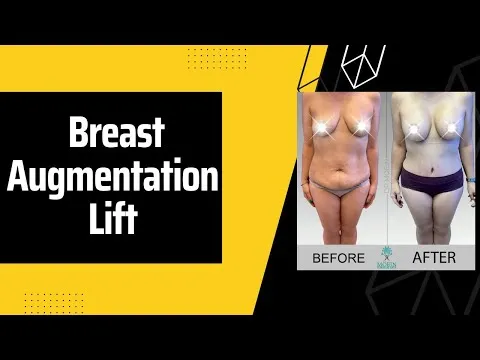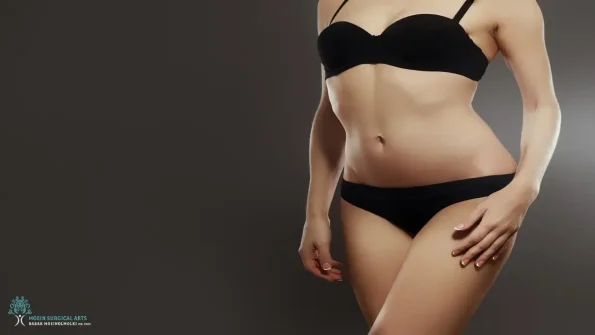
Our Post-Bariatric Body Contouring Program is a specialized initiative aimed at assisting individuals who have undergone significant weight loss following bariatric surgery. This program is developed in collaboration with our HealthylifeBariatrics Program, ensuring a comprehensive approach to post-weight loss body contouring, termed our 360 Care Plan.
The program offers a range of procedures designed to address the specific needs and concerns of post-bariatric patients. These procedures include arm lift, breast lift/reshaping or reduction, tummy tuck, thigh lifts, and liposuction. Through these procedures, the program aims to improve body shape and tone, tackle issues such as excess skin and sagging, and enhance overall body contour.
The Post-Bariatric Body Contouring Program follows a multidisciplinary approach to ensure the best possible outcomes for patients. The team consists of experts in plastic surgery, bariatric surgery, nutrition, and psychology. This collaborative approach allows for a comprehensive evaluation of each patient's specific goals and needs, taking into account their overall health and well-being.
In summary, the Post-Bariatric Body Contouring Program is a specialized initiative in collaboration with our Healthylifebariatrics Program. It offers a range of procedures to address the unique needs of post-bariatric patients, with the goals of improving body shape and tone. The program involves a multidisciplinary team of experts to ensure comprehensive care and optimal outcomes.

Post-Bariatric Body Contouring is a surgical procedure designed to remove excess skin and reshape the body after significant weight loss. This transformative surgery can help individuals achieve their desired body shape and improve their overall physical appearance. However, it is essential to understand that not everyone is a suitable candidate for this procedure. To determine whether someone is a good candidate for Post-Bariatric Body Contouring, various factors need to be considered, including their overall health, weight stability, expectations, and commitment to maintaining a healthy lifestyle.
Additionally, it is crucial to consult with a qualified cosmetic surgeon who can assess the individual's specific circumstances and advise on the suitability and potential outcomes of the procedure. By identifying the right candidates, Post-Bariatric Body Contouring can provide an opportunity for individuals to complete their weight loss journey by achieving a slimmer, well-proportioned body and boosting their self-confidence.
Preoperative clearance is an essential step in preparing for post-bariatric body contouring surgery. This process ensures that a patient is in optimal health before undergoing such procedures. The necessary steps to obtain preoperative clearance include a complete medical evaluation, which includes a thorough assessment of the patient's medical history, physical examination, and any necessary laboratory or imaging tests.
The importance of a complete pre-operative medical evaluation cannot be overstated. It helps identify any underlying medical conditions or risk factors that may affect the safety or outcome of the contouring procedures. It also allows the surgeon to determine if additional consultations or specialist evaluations are required before proceeding with the surgery.
The timeline for initiating contouring procedures after obtaining preoperative clearance can vary depending on a patient's individual circumstances. Generally, it is recommended to wait at least 12-18 months after bariatric surgery to allow for weight stabilization and optimal healing. Additionally, patients should reach and maintain a stable BMI (Body Mass Index) within the recommended range before considering body contouring surgery.
When determining which areas to address first and the potential combination of procedures, several key factors must be considered. These factors include the patient's desired outcomes, the extent of excess skin and fat in different body regions, and the surgeon's recommendations based on their assessment. Common combination procedures include abdomino plasty(tummy tuck), brachioplasty (arm lift), thigh lift, breast lift, and buttock lift.
After undergoing significant weight loss following bariatric surgery, many patients seek post-bariatric body contouring procedures to address excess skin and achieve a more balanced physique. However, it is important to consider the nutritional needs of these individuals to ensure optimal healing, recovery, and long-term health. In this article, we will explore the nutrition considerations that should be taken into account before, during, and after post-bariatric body contouring procedures. By understanding the unique dietary requirements of these patients, healthcare professionals can provide appropriate guidance and support to enhance their overall outcomes.
Post-bariatric patients are at increased risk of developing deficiencies in iron, folate, and vitamin B12, which can lead to anemia. The main cause of these deficiencies is the altered digestive system and decreased absorption of nutrients after bariatric surgery.
Iron deficiency is common in post-bariatric patients due to reduced gastric acid production and decreased absorption in the small intestine. Inadequate iron intake or poor dietary choices can exacerbate this deficiency. Folate deficiency occurs due to the anatomical changes in the gastrointestinal tract, which limit the absorption of folate. Additionally, the reduction in stomach acid production can increase the risk of folate deficiency. Vitamin B12 deficiency is also prevalent in these patients due to the rearrangement of the digestive system, causing impaired absorption from food sources.
Anemia can result from these deficiencies as iron, folate, and vitamin B12 play crucial roles in red blood cell production. When these nutrients are deficient, the body cannot produce enough healthy red blood cells, leading to anemia.
While vitamin supplementation is commonly prescribed to post-bariatric patients, it has limitations in treating these deficiencies. The altered physiology of the digestive system may still hinder proper absorption of vitamins, making supplementation less effective. Therefore, it is imperative to emphasize the importance of proper nutrition and adherence to dietary instructions. Consuming a nutrient-dense diet rich in iron, folate, and vitamin B12, along with regular monitoring of blood levels, can help prevent deficiencies and optimize post-bariatric patient outcomes.
Protein deficiency is a potential consequence that can occur following Roux-en-Y gastric bypass surgery. This type of surgery involves creating a small stomach pouch and rerouting the small intestine, which can affect nutrient absorption and digestion.
Several factors contribute to protein deficiency after gastric bypass surgery. Firstly, the reduced stomach size means that patients are limited in the amount of food they can consume, leading to a restricted dietary intake. Secondly, the rerouting of the small intestine can result in decreased absorption of nutrients, including proteins. Additionally, patients may experience symptoms such as nausea, vomiting, and early satiety, further impacting their ability to consume an adequate amount of protein.

To prevent muscle breakdown and promote healing after surgery, it is essential for postoperative patients to follow recommended protein intake guidelines. The guidelines generally suggest consuming 60 to 80 grams of protein daily for these patients. This amount may vary depending on factors such as body weight, activity level, and individual nutritional needs. Consuming protein-rich foods such as lean meats, fish, dairy products, and legumes is recommended. However, many patients may struggle to meet these protein requirements solely through food intake, and protein supplements or shakes may be suggested to ensure adequate protein intake.
Thiamine deficiency is a condition that occurs when there is a lack of thiamine, also known as vitamin B1, in the body. Thiamine is essential for the proper functioning of the nervous system and the metabolism of carbohydrates. Without sufficient thiamine, various symptoms and manifestations can occur, leading to different conditions such as Beriberi and Wernicke encephalopathy.
Beriberi is a disease caused by thiamine deficiency, characterized by weakness, loss of appetite, weight loss, and fatigue. It can also lead to edema, or swelling, in the arms and legs, as well as neuropathy, which can cause tingling and numbness. Beriberi usually affects individuals who consume a diet low in thiamine, such as those who heavily rely on polished rice.
Wernicke encephalopathy is the most severe manifestation of thiamine deficiency. It primarily affects the central nervous system and can lead to neurological symptoms such as confusion, difficulty walking, and abnormal eye movements. In advanced cases, Wernicke encephalopathy can progress to Korsakoff syndrome, characterized by severe memory loss and confabulation.
Administering dextrose intravenously to undiagnosed thiamine-deficient patients can be problematic. Dextrose, a form of sugar, stimulates the metabolism of carbohydrates, which further increases the body's thiamine requirements. In individuals deficient in thiamine, prolonged administration of dextrose can deplete the already limited thiamine stores, leading to the development or worsening of Wernicke encephalopathy.
Gastric bypass surgery is a common procedure used to achieve weight loss in severely obese individuals. While it can lead to significant improvements in health and weight reduction, it also poses several risks and complications, including the development of metabolic bone disease. Calcium deficiency and vitamin D deficiency are two key factors that contribute to the postoperative development of this condition.
Calcium is an essential mineral for maintaining healthy bones. It is primarily absorbed in the small intestine, which is bypassed in gastric bypass surgery. This bypass results in reduced calcium absorption, leading to calcium deficiency. Vitamin D plays a crucial role in calcium metabolism, as it helps the body efficiently absorb calcium. However, the impaired absorption of fat-soluble vitamins, including vitamin D, after bariatric procedures, can lead to vitamin D deficiency.
The combination of calcium deficiency and vitamin D deficiency significantly increases the risk of developing metabolic bone disease, such as osteoporosis. Insufficient calcium and vitamin D levels can negatively impact bone mineralization and density, leading to weak and brittle bones. This can result in an increased risk of fractures and other skeletal complications in postoperative patients.
Postoperative surveillance and appropriate supplementation are crucial in preventing and managing bone disease in these patients. Regular monitoring of calcium and vitamin D levels, along with bone density assessments, can help detect deficiencies and bone disease at an early stage. Supplementation with calcium and vitamin D is often recommended to meet the increased needs of post-bariatric surgery patients and prevent long-term complications.
Bariatric procedures can also lead to deficiencies in other fat-soluble vitamins, namely, vitamin A, E, and K. Vitamin A deficiency can impair vision and immune function, while vitamin E deficiency can lead to neurological complications and impaired wound healing. Vitamin K deficiency can cause abnormal bleeding and clotting issues. Thus, routine monitoring and appropriate supplementation of these vitamins are vital to prevent associated clinical implications.

Miscellaneous Fat-Soluble Vitamin Deficiencies: Vitamins A, E, and K in Bariatric Surgery Patients Bariatric surgery is a common weight-loss procedure that can lead to various deficiencies, including those of fat-soluble vitamins A, E, and K. These vitamins are critical for proper bodily functions, and their deficiencies can cause detrimental health effects.
Vitamin A deficiency is a significant concern in bariatric surgery patients due to their reduced ability to absorb fat-soluble vitamins. This deficiency can lead to night blindness, dry eyes, dry skin, impaired immune function, and even vision loss. The clinical significance of vitamin A deficiency lies in its crucial role in cell differentiation, growth, and development, and maintaining healthy eyesight.
To ensure optimal health outcomes, bariatric surgery patients must undergo regular monitoring of their vitamin A levels. This can be achieved by measuring retinol levels in the blood. If deficiencies are detected, appropriate supplementation is necessary to avoid severe complications. Recommendations for monitoring and supplementing vitamin A levels in these patients include regular blood tests and tailored vitamin A supplements according to individual needs.
Introduction:
Post-bariatric body contouring procedures are a crucial part of the comprehensive approach to address the physical transformation that occurs after significant weight loss. These procedures aim to remove excess skin and reshape the body for individuals who have achieved massive weight loss through surgical intervention or other means. To achieve desirable results, a combination of surgical techniques is typically employed, such as body lift, arm lift, thigh lift, breast lift or augmentation, and abdominoplasty. These procedures not only eliminate the loose and sagging skin but also help enhance body proportion, improve physical comfort, and boost self-confidence. However, it is essential to understand the specific procedures involved in post-bariatric body contouring to make informed decisions and achieve the desired outcomes.
The correction of back rolls, specifically in an upper body lift procedure, often involves the technique of direct excision. This method aims to remove excess skin and fat in the back area to achieve a more contoured and smoother appearance.
Prior to the surgery, the surgeon carefully assesses the patient's back to determine the extent of correction required. The upper marking, which serves as a guideline for the procedure, is made pre-operatively using the patient's bra as a reference point. This allows the surgeon to accurately identify the areas where back rolls are most prominent and plan for their removal.
During the surgery, the incisions are strategically placed to ensure minimal scarring and a more discreet outcome. In some cases, the incisions may not need to cross the midline, depending on the individual's specific requirements. This allows for a hidden scar effect, as the incisions are carefully positioned and concealed within natural skin creases or along the bra line.
Direct excision involves the removal of excess skin and fat through the carefully planned incisions. This technique allows for precise sculpting of the back contour and ensures a smoother, more toned appearance. Once the excess tissue is removed, the remaining skin is meticulously repositioned and sutured for optimal results.
During a lower body lift, incisions are strategically placed to minimize visible scarring. The incisions typically extend around the waistline, from the back to the front, and then downwards along the inner thighs. These incisions allow the surgeon to remove excess skin and fat, tighten underlying muscles, and lift the thighs in a single stage.
One of the key benefits of a lower body lift is the improved ability to lift the thighs. By removing excess skin and fat from the inner thigh area, the procedure can create a smoother, more toned appearance. This is particularly beneficial for individuals who have experienced sagging or drooping skin due to weight loss or aging.
The final scar from a lower body lift is positioned in relation to the buttock and lower back. The scar typically sits low on the waistline, just above the buttock crease. This placement helps to conceal the scar under underwear or swimwear, minimizing its visibility.
It is important to note that a lower body lift is different from a belt lipectomy. While both procedures involve removing excess skin and fat from the lower body, a belt lipectomy specifically focuses on the waistline. Therefore, a belt lipectomy may produce more dramatic improvements in the waistline area compared to a lower body lift.

The Breast Lift procedure is a surgical technique aimed at restoring the appearance and shape of the breasts after significant weight loss. The journey of weight loss can bring about numerous changes and deformities in the female breast, which may include deflation, ptosis, nipple-areola complex medialization, and skin laxity. Understanding these changes is crucial in order to effectively address them through the breast lift procedure.
One of the primary concerns after massive weight loss is breast deflation, where the breasts lose volume and appear saggy and empty. This occurs when the skin and underlying tissues are stretched during the weight gain phase, but cannot contract enough to maintain firmness and elasticity post-weight loss. Ptosis, or breast drooping, is another issue commonly experienced after massive weight loss. The breasts tend to lose their natural shape and position, resulting in a downward displacement of the nipple-areola complex.

Furthermore, nipple-areola complex medialization can occur due to the overlying skin laxity after weight loss. The nipple and areola may shift downwards, causing an unbalanced appearance and contributing to the overall lack of breast projection. Lastly, skin laxity is a result of excessive stretching during weight gain and subsequent loss. The skin becomes loose and lacks the necessary tightness and elasticity required for a youthful and perky breast appearance.
In order to address these issues, a breast lift procedure involves surgically removing excess skin, lifting and reshaping the breast tissue, repositioning the nipple-areola complex to a higher location, and restoring volume with the use of implants if necessary. By understanding the changes that occur after massive weight loss, cosmetic surgeons can tailor the breast lift procedure to address each patient's specific needs and provide them with a more youthful, lifted, and shapely breast appearance.
The technique for addressing the Next Heading, "Medial Thigh Tuck", involves a surgical procedure that aims to address the cylindrical variant of thigh deformities. This technique utilizes a combination of horizontal and vertical skin resection to achieve the desired outcome.
During the surgical procedure, an incision is made along the medial aspect of the thigh, following the natural crease. The incision extends from the groin fold to the knee area. Once the incision is made, the excess skin and soft tissue are carefully removed.
To address the cylindrical variant of thigh deformities, the surgeon performs a combination of horizontal and vertical resections. Horizontal resections involve removing excess skin and tissue from the circumference of the thigh. This helps to reduce the overall diameter of the thigh, resulting in a more contoured appearance.
Vertical resections, on the other hand, involve removing excess skin and tissue in a vertical direction. This helps to correct any sagging or drooping of the thigh, providing a more lifted and toned appearance.
By utilizing both horizontal and vertical resections, the medial thigh tuck technique is able to address the cylindrical variant of thigh deformities effectively. This surgical approach allows for a comprehensive reshaping of the thigh, resulting in improved contour and aesthetics.
Brachioplasty, also known as an arm lift, is a surgical procedure designed to improve the appearance of the upper arms by removing excess skin and fat. There are several techniques available for brachioplasty, each with its own advantages and considerations.
Traditional brachioplasty involves making an incision along the inner arm, commonly extending from the armpit to the elbow. This technique allows for extensive removal of excess skin and fat, resulting in a significant improvement in arm contour. However, it does leave a visible scar along the inner arm.
Another technique includes the use of axillary Z-plasty. This involves making a Z-shaped incision in the armpit, which allows for the repositioning of the scar to a less conspicuous location. Axillary Z-plasty is particularly useful in cases where the excess skin and fat are predominantly located in the armpit region.
Liposuction combined with limited incision medial brachioplasty is an alternative technique that is suitable for patients with excess fat and minimal skin laxity. This technique involves making a small incision near the armpit, through which liposuction is performed to remove excess fat. This is followed by a limited incision on the inner arm to remove any remaining excess skin.
In cases where the anatomic deformity is mostly located in the lower portion of the arm, an inferiorly-placed scar with axillary Z-plasty can be utilized. This technique involves making an incision along the lower border of the arm, which allows for the removal of excess skin and fat while also repositioning the scar toward the back of the arm, where it is less visible.
The selection of the appropriate brachioplasty technique should be based on the specific location of the excess skin and fat, as well as the patient's individual goals and preferences. A consultation with a qualified Cosmetic Surgeon is necessary to determine the most suitable technique for each patient's unique conditions.


A tummy tuck, also known as abdominoplasty, is a surgical procedure that aims to remove excess abdominal skin and tighten the underlying muscles. This procedure is often performed on individuals who have lost a significant amount of weight or have had multiple pregnancies, resulting in loose or sagging abdominal skin.
The procedure starts with the patient being placed under general anesthesia. The surgeon then makes an incision from hip to hip, just above the pubic area. The length and shape of the incision may vary depending on the extent of excess skin that needs to be removed. The surgeon then carefully lifts the skin and fat away from the abdominal muscles.
Next, the surgeon sutures the underlying abdominal muscles together, creating a firmer and flatter abdominal wall. This step is particularly beneficial for individuals who have experienced muscle separation or weakness due to pregnancy or weight gain. The excess skin and fat are then removed from the lower abdomen, and the remaining skin is pulled downward and sutured back into place. Any existing belly button opening is also repositioned.
The purpose of a tummy tuck is to achieve a more toned and contoured abdomen by removing excess skin and fat. Unlike other body contouring surgeries like mastopexy and brachioplasty, which focus on specific areas such as the breasts or arms respectively, the tummy tuck provides a more comprehensive enhancement of the abdominal area. While mastopexy lifts sagging breasts and brachioplasty removes excess skin from the arms, the tummy tuck targets the entire abdominal region, resulting in a flatter and more sculpted belly.
The total body lift is a surgical procedure that aims to contour and tighten the entire body by removing excess skin and fat. It is typically performed on patients who have experienced significant weight loss or have excess skin due to aging or pregnancy. The procedure involves making incisions in strategic areas to access and remove excess skin and fat.
The necessary incisions for a total body lift vary depending on the individual patient's needs, but commonly include incisions along the lower abdomen, around the waistline, on the back, and sometimes extending to the inner thighs and buttocks. These incisions allow the surgeon to remove excess skin and fat from multiple areas and achieve a comprehensive body contouring result.
The techniques used in a total body lift include skin excision, liposuction, and tissue tightening. The surgeon will evaluate each patient and tailor the approach to their specific needs. The excess skin and fat are carefully removed, and the remaining skin is re-draped and tightened to create a more toned and youthful appearance.
The total body lift differs from the lower body lift in that it addresses the entire body rather than just the lower half. While the lower body lift focuses on the abdomen, buttocks, and thighs, the total body lift encompasses these areas as well as the upper body, such as the back and breasts. The benefit of a total body lift is that it provides a more comprehensive transformation and allows for a more balanced overall result. However, the drawback is that it is a more extensive procedure and may require a longer recovery time.
In patients who have experienced massive weight loss, characteristic folds can be found on the posterior trunk. These include the bra line, hip roll, and lower back folds. These folds can be aesthetically undesirable and can impact a patient's self-confidence. The total body lift aims to eliminate these folds and create a smoother and more contoured silhouette.
The concept of belt lipectomy was originally described by Gonzalez-Ulloa. This procedure involves making an incision around the entire waistline, allowing for the simultaneous removal of excess skin and fat from the abdomen, lower back, and hips. This technique is often employed in a total body lift to achieve optimal results.
Overall, the total body lift is a comprehensive surgical procedure that addresses excess skin and fat throughout the body. It differs from the lower body lift by targeting the entire body rather than just the lower half, providing a more balanced transformation. While it may have a longer recovery time, the total body lift allows for a more comprehensive contouring and improvement of a patient's overall appearance.
Post-bariatric body contouring is a surgical procedure that helps to remove excess skin and fat after significant weight loss. The recovery process for this procedure may vary depending on the specific procedures performed and the extent of work needed.
Following the surgery, patients are advised to strictly adhere to pre and postoperative instructions to ensure a quick and healthy recovery. These instructions may include taking prescribed medications as directed, keeping the surgical incisions clean and dry, and avoiding activities that may put strain on the surgical area.
It is crucial to understand the importance of avoiding exercise and strenuous activities during the three to four week recovery period. Engaging in physical activities too soon after surgery can lead to complications and hinder the healing process. It is recommended to take this time to rest, allowing the body to heal and adjust to the changes made during the procedure.
The recovery period may vary based on the specific procedures performed, the extent of work needed, and individual healing capabilities. Some patients may require longer recovery periods if multiple procedures are performed simultaneously or if extensive work is needed.
In summary, post-bariatric body contouring recovery requires strict adherence to pre and postoperative instructions. Avoiding exercise and strenuous activities during the three to four week recovery period is crucial for ensuring a quick and healthy recovery. Individual variations in procedures and the extent of work needed should also be taken into consideration when planning for the recovery process.
Post-bariatric body contouring procedures have been shown to have significant impacts on patients' functional and cosmetic concerns, resulting in improved hygiene, enhanced ability to exercise, and prevention of skin-related issues.
One of the main benefits of post-bariatric body contouring is improved hygiene. Excess skin folds and pockets can be challenging to clean properly, leading to increased risk of infections and odors. By removing this excess skin through body contouring procedures, patients experience improved cleanliness and comfort, which in turn can enhance their overall quality of life.

Additionally, body contouring procedures allow patients to engage in regular exercise more effectively. The removal of excess skin and fat allows for improved mobility and flexibility, enabling individuals to undertake physical activities that were previously difficult or even impossible. This increased ability to exercise can lead to weight maintenance and the preservation of the health benefits achieved through bariatric surgery.
Post-bariatric body contouring also helps prevent skin-related issues such as rashes, irritation, and chafing. Excess skin can rub against itself or clothing, causing discomfort and leading to various skin problems. By removing this excess skin, body contouring procedures alleviate these issues, ensuring patients can maintain healthy and irritation-free skin.
Timing plays a critical role in post-bariatric body contouring procedures to ensure optimal results. It is advised to wait for at least six months after achieving stable weight loss before considering these procedures in order to allow the body to adapt to its new shape. Additionally, meeting the nutritional requirements recommended by healthcare professionals is crucial to promote proper healing and minimize the risk of complications.
Six major areas of the body that can be addressed through post-bariatric body contouring include the abdomen, arms, breasts, thighs, buttocks, and face/neck. The combination of procedures in these areas depends on factors such as the patient's overall health, surgical goals, and individual preferences. The surgeon will assess each patient's unique situation and recommend the most suitable combination of procedures to achieve the desired outcomes.
In summary, post-bariatric body contouring procedures offer significant functional and cosmetic improvements for patients. These procedures can enhance hygiene, enable better exercise capabilities, and prevent skin-related issues. Timing is crucial, with stable weight loss and meeting nutritional requirements being key considerations. By addressing the six major areas of the body, surgeons can tailor a combination of procedures to best suit each patient's needs and goals, ultimately leading to satisfying and transformative results.
Post-Bariatric Body Contouring is an aesthetic surgical procedure performed on individuals who have undergone significant weight loss after bariatric surgery. While the procedure aims to improve the appearance of excess skin and contour the body, there are certain risks associated with it.
One of the primary risks of Post-Bariatric Body Contouring is infection. Since the procedure involves making incisions, there is a chance that bacteria can enter the body, leading to infection. This risk can be mitigated through proper surgical hygiene and post-operative care.
Other potential complications and side effects include seroma formation, hematomas, excessive bleeding, poor wound healing, and scarring. Seromas are pockets of fluid that can form under the skin, causing swelling and discomfort. Hematomas are collections of blood that can accumulate under the incision site, resulting in pain and the need for additional drainage.
Certain factors can increase the risk of complications in Post-Bariatric Body Contouring. These include smoking, obesity, diabetes, poor nutrition, and a history of previous surgeries. Individuals with these risk factors should be closely monitored before and after the procedure to minimize the likelihood of adverse events.
Post-bariatric body contouring is a surgical procedure that aims to remove excess skin and reshape the body after significant weight loss. Like any other surgical procedure, there are several cost factors and considerations associated with post-bariatric body contouring.
The cost of the procedure can vary based on individual patient factors and the specific areas of the body being addressed. Factors such as the extent of the excess skin, the complexity of the procedure, and the surgeon's experience can all impact the cost. Additionally, the geographic location of the practice can also play a role in the overall cost.
In terms of the specific areas of the body being addressed, the cost can vary depending on the number and complexity of the areas being treated. Common areas that are addressed in post-bariatric body contouring include the abdomen, breasts, arms, thighs, and buttocks.
In addition to the primary procedure cost, there may be potential additional costs involved. This can include anesthesia fees, which are typically charged on an hourly basis, and facility fees, which cover the use of the operating room, supplies, and equipment. These additional costs can vary depending on the surgeon and the location.
It is important for individuals considering post-bariatric body contouring to obtain a personalized cost estimate from a qualified Cosmetic Surgeon. This will allow them to have a clear understanding of the total cost involved and ensure there are no surprises. It is also important to consider the long-term benefits and improvements to quality of life that can result from the procedure.
In summary, post-bariatric body contouring is of utmost importance in addressing the skin excess and functional issues that arise as a result of massive weight loss. It not only improves the physical appearance of individuals but also helps to restore functionality and comfort, which may have been compromised due to excess skin.
Timing considerations play a crucial role in determining the success of body contouring surgery. It is important for individuals to achieve stable weight loss before undergoing the procedure to ensure long-lasting results. Additionally, meeting nutritional requirements is essential to support the body's healing process and reduce the risk of complications.
During post-bariatric body contouring, six major areas of the body are typically addressed. These include the abdomen, breasts, arms, thighs, buttocks, and face. Each area presents its unique challenges in terms of excess skin and functional issues, and it is important to comprehensively address all areas to achieve a harmonious and balanced outcome.
Post-bariatric body contouring and recovery process will vary based on the patient and Dr. Moein’s expertise. Dr. Moein will begin the procedure by strategically marking the areas of concern to prepare for the incisions. Dr. Moein will then carefully remove the excess skin to contour the body.
Explore your options at Moein Surgical Arts and book your consultation with our friendly staff today.